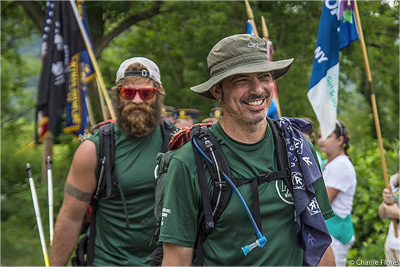By Catherine Carmel , Special to JTNews
“For 32 years, my job has been to be a soldier. Now my job is to get up every morning and put one foot in front of the other until I get to Katahdin,” says my husband, Rob Carmel, when he has been asked how hiking the Appalachian Trail has changed his life. He is a man of few words, a leader in his community of former soldiers, walking off the war like Earl Shaffer did 65 years earlier.
In 1948, Shaffer decided he was going to “walk off the war” to work out the experiences of World War II. Four months later he became the first person to hike the entire length of the Appalachian Trail from Georgia to Maine.
Now Rob and a small group of veterans are walking off the experiences from their more recent deployments through Warrior Hike, a non-profit organization that helps veterans process their experiences by thru-hiking the 2,200-mile trail. Partnering with the Appalachian Trail Conservancy, Warrior Hike created the “Walk Off the War” program in light of the psychological, spiritual, and physical benefits of hiking.
Rob, who is using this experience as a way to transition from active duty to retirement, is the oldest of this year’s Warrior Hike group, having turned 50 on the trail in May. The group started with 14 men and women, four of whom will complete the full hike.
Rob has had four deployments — to Somalia, Kuwait, Iraq and Afghanistan in the field artillery specialty — sometimes being responsible for thousands of soldiers at a time. Though he never suffered any glaring physical injuries, he has seen friends and co-workers killed, children blown up by Iraqi suicide bombers, and he carries guilt for each family who had a soldier come home in a box because he sent him to do a job. If he didn’t have PTSD, I’d be worried.
While Rob went to Georgia looking forward to finally not being a leader, his quiet determination and commitment put him squarely in that position again.
“We all have similar goals, but this hike isn’t for everyone,” he says. “You have to commit yourself completely; there is no halfway if you want to finish.”
Rob tries to inspire the others, but is thankful not to be responsible for their lives.
“Trail life is not so different from real life,” he says. “Some days are sunnier than others. Sometimes your path is unclear. We have days that feel like uphill climbs — usually because they are — but we help each other get through it.”
The hikers get support from “trail angels,” people who provide for them, give them rides and places to stay, and sometimes even snacks and water left anonymously by the side of the trail. Initially, it was difficult for Rob to accept the generosity of strangers. He eventually came to accept and appreciate the “trail magic.”
The last day of Rob’s hike begins and ends on opposite sides of Mount Katahdin, the tallest mountain in Maine. That day happens to fall on Yom Kippur. Our initial thought was that it was extremely inconvenient that he would be hiking through the High Holidays. I grumbled about the frustrations of living as a Jew in a Christian world. Don’t people understand the need to be at services?
Then I realized how impressive that significance is for us as Jews. Each year, our Jewish traditions provide us with an opportunity to take stock of ourselves and the lives we lead, to note where we have fallen short, and what we can do to improve ourselves. By beginning the process a month before, we have the opportunity to proceed deliberately, so we view teshuva — repentance — as a challenge rather than an impossibility. To be successful, we must push ourselves to improve, but we also must realize our limitations. We can be aware of the immense spiritual challenge before us while still knowing that the only way we can even begin to meet that challenge is to take it one step at a time.
Like the preparation for the High Holidays, through-hiking is a reflective practice. Stepping out of regular patterns allows us to deeply contemplate our lives. We can acknowledge our strengths and come to terms with our challenges. This reflection allows us to see beyond ourselves to our relationships, commitments, communities, and responsibilities. One step at a time, we begin to see our connections more clearly.
As Rob travels through this process, he can come home with meaningful insight into how to move back into our community while taking on a new role. This challenging hike is preparing him for not only a new year, but a new life. As he pushes himself and his fellow veterans to continue to put one foot in front of the other, they are putting the years they spent deployed behind them, hiking toward a more complete healing.
When Rob returns, he will have had the time he needed to let go of the experiences of war as he moves into a new year and a new life. When you hear the shofar blow, closing this year’s reflective journey on Yom Kippur, remember Rob stepping off the trail, returning to the Pacific Northwest, and a life renewed.
Catherine Carmel is director of Jewish Family Life & Learning at Temple Beth Hatfiloh in Olympia.
